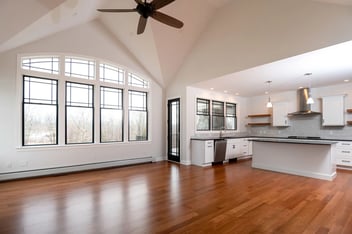4 Min Read
The Pros and Cons of Radiant Heat
Winter is coming, and with it, cold toes in the morning. If you're considering a custom home or perhaps just want to upgrade the heating in your own home, you might be wondering about the pros and cons of radiant heat. Here, we'll break down the pros and cons and answer a few of the most frequently asked questions about radiant heating.
What are the Pros and Cons of Radiant Heat?
Like any heating solution, radiant heat has pros and cons, and it’s important to weigh these carefully when deciding if it’s right for your home. At GTG Builders, we want to help you make the right choice for your home and family.
Advantages of Radiant Floor Heating
Let's discuss the advantages of radiant floor heating. You'll notice that many of them make it an excellent choice for new builds and can bring you year-round comfort. Let's get started so that you can be better informed!
1. Even Heat Distribution
2. Energy Efficiency
3. Silent Operation
4. Allergy-Friendly
Disadvantages of Radiant Floor Heating
While we're discussing the cons of radiant floor heating, you'll notice that the majority of them impact older homes. Many of the disadvantages can be mitigated when you're building a new home.
1. High Installation Costs in Older Homes
One primary disadvantage is the high installation cost, particularly in retrofitting an existing home. For new construction, radiant floor heating can be incorporated more easily, but for older homes, it requires lifting the floor to install the system, which can be time-consuming and costly.
2. Slow to Warm Up
3. Repair Difficulty
4. Flooring Materials
Ceramic tiles and stone floors are excellent heat conductors. Some types of carpeting and hardwood may not transfer heat as effectively, limiting flooring choices or reducing system efficiency. If you're installing radiant heat in a new custom home, make sure you choose the flooring that works with, not against, repairing your radiant floor heating system.How Does Radiant Heat Work?
Radiant heating works by directly warming surfaces, which in turn radiate heat to the rest of the room. In a hot water radiant floor heating system, for example, heated water circulates through tubes installed beneath the floor. As the floor warms up, it radiates heat upward, warming the room evenly from the ground up. The result is a more consistent and natural warmth compared to forced-air systems, which heat air that can quickly rise and dissipate.
Is Radiant Heat Safe?
Yes, radiant heat is generally considered very safe. Since it doesn’t rely on moving air, there’s no risk of blowing dust, allergens, or pollutants around your home, making it a cleaner option for people with allergies. The systems are also designed to operate at safe temperatures so floors cannot become dangerously hot. However, regular maintenance and proper installation are key to ensuring long-term safety and efficiency like any heating system. For instance, poorly installed electric radiant systems could pose electrical risks, while poorly maintained hydronic systems may develop leaks.
Does Radiant Heat Dry the Air?
Radiant heat does not dry the air like forced-air heating systems. Unlike forced-air systems, which circulate heated air that can reduce humidity, radiant heating works by directly warming objects and surfaces. This heating method maintains a more stable level of humidity in the room because it doesn’t move or condition the air. As a result, radiant heat is often more comfortable, especially in the winter, when indoor air becomes dry. If dry winter air leaves you scrambling for a humidifier, radiant heat might be a great choice for your custom home.
How Long Do Heated Floors Take to Heat Up?
The time it takes for radiant heated floors to warm up depends on several factors, including the type of system (electric or hydronic), the insulation beneath the floor, and the type of flooring installed. On average, electric radiant floor heating systems can take anywhere from 30 minutes to 2 hours to fully heat up. Hydronic systems, which use hot water flowing through tubes under the floor, typically take longer—usually between 2 and 8 hours—because water-based systems have more thermal mass and require more energy to warm up.
Radiant Floor Heating and New Construction
Radiant floor heating is often a smart investment for new construction projects. Since the floors are being installed from scratch, laying the necessary tubing or electric cables beneath the flooring is easier. Additionally, new homes can be better insulated from the ground up, which is critical for ensuring that radiant heat systems work as efficiently as possible. Our homeowner resources can help you decide if this sort of heating system is right for your home.
Best Floor Heating Systems
Consider your home's specific needs when choosing the best floor heating system. Electric systems are generally more suitable for small spaces or renovations, while hydronic systems are more cost-effective for larger areas or whole-house heating. Proper heated floor insulation and careful attention to radiant heat design are crucial for ensuring maximum efficiency, comfort, and longevity.
In conclusion, radiant heat offers a comfortable, energy-efficient alternative to traditional heating methods without drying out the air. With proper installation and maintenance, radiant heating systems can provide safe and long-lasting warmth for any home. Our process can help you decide if this is right for your home.
Your Central New Jersey Home Experts
If you're considering installing radiant home heating or want to discuss more options for your new custom home, GTG Builders is ready and able to help.
Contact us today to see what we can do for you!




%20(1).jpg?width=352&name=NP2_1484%20(1)%20(1).jpg)